Cooking and Fire
All content copyright © 2010-2024 Frank Revelo, www.frankrevelo.com, United States copyright office registration number TX-7931345
Cooking, especially in rain or wind, and the smoke and mess associated with fire, were aspects of my early exposure to camping, with the Boy Scouts, that I most despised. As an adult, I have never cooked or made a fire while camping and I don't ever plan to. But in order to convince myself that cooking and fire are unnecessary, I first did some research on the state of the art in lightweight cooking systems.
Lightest cookware is aluminum, but titanium is almost as light and more durable, and thus a better choice. Titanium is currently more expensive than aluminum, though not outrageously so for someone who camps frequently. Some very lightweight and efficient cook systems require a specific sized pot. Other than for cooking on wood stoves, where fuel is unlimited, wider pot normally better than narrow pot, so that all of heat from fire underneath hits bottom of pot, rather than escaping around sides. For one person, 1.3 liters is the minimum size pot for cooking pasta for one person, and 2 liters probably better. For simply boiling water for use with dehydrated foods, smaller pot might be okay. Evernew 1.3 liter uncoated titanium pot, at 130 grams including lid, is a good choice. I bought from BackpackingLight, but ClikStand also sells it (and so does CycloCamping.com as of 2014). REI also used to sell this pot, but then switched to selling only coated version, which weighs about 30 grams more. I read reports that non-stick coating is not particularly durable, even if used exclusively with a non-metal spoon. I recommend going with uncoated and then avoid cooking foods that might stick.
Lightest source of heat for cooking is wood, but this is illegal in many areas due to fire hazard. Where wood fires are permitted, wood stove systems should be carefully considered, because of the huge advantage of unlimited fuel. Note that there is no need to cut wood or use large pieces of wood for simply cooking pasta or boiling water. In fact, tiny twigs are better than larger pieces of wood because they burn faster and hotter. Wood stove system would consist of: metal stove with provision for air entering from below and flames exiting above; pot big enough to rest on top of stove while cooking and to hold stove while carrying in backpack; some way of grasping and removing hot pot from stove; some way of starting fire when twigs are damp (such as cotton/rayon tabs soaked in vaseline); some way of cleaning both stove and pot (such as rotating against dirt or sand). I have no experience with wood stove systems myself.
Most hikers use alcohol or butane gas stoves. Butane gas cartridges for backpacking stoves are normally only available at specialized outdoor stores, whereas alcohol is normally more widely available. So where fuel availability is a concern, alcohol is normally a better choice.
Of alcohols available for burning in stoves, ethyl alcohol aka ethanol has highest energy content. In most countries, 90% or higher denatured ethyl is available in pharmacies as skin care product. "Denatured" means that alcohol has been mixed with poisonous substances so that it cannot be drunk. Denatured ethyl alcohol also widely available at hardware stores (in cleaning supplies or solvents department) and also in larger supermarkets in Europe (in cleaning supplies department, or perhaps cookware department, for use in chafing dishes). Ethanol also widely used in marine stoves, and so can usually be found in boating supply stores. Methyl alcohol aka methanol gas-line antifreeze (HEET in yellow bottle) widely available in the United States at gas stations and auto parts stores. Methanol is highly toxic, so avoid getting on the skin, and especially avoid swallowing or getting in eyes. Methanol burns cleanly but produces only about 75% as much heat as ethanol, per unit of liquid fuel. Avoid isopropyl alcohol aka isopropanol (HEET in red bottle, rubbing alcohol in skin care department at pharmacies in the United States), which makes a sooty flame, especially if mixed with 30% water, as is common for isopropyl alcohol intended for skin care in the United States. Any plastic can be used for holding alcohol fuel, since alcohol, unlike white gas and other liquid fuels, is not particularly combustible and doesn't leave nasty residue if spilled. (Though methanol, as noted, is highly toxic until it evaporates.)
Rule of thumb for remembering which alcohol works best in stoves is as follows. Traffic lights use red/yellow/green to signal no/maybe/yes for movement. Red HEET (isopropyl alcohol) = no. Yellow HEET (methyl alcohol) = maybe. Green would then signify ethyl alcohol (regardless of color container it actually comes in).
There are many ultralight alcohol cooking systems, but most are of dubious reliability, especially in windy or other challenging conditions. Sturdy solution is as follows:
- Trangia burner, cap, spare o-ring, simmer lid, from ClikStand, 115 grams.
- T-2 stand, 2 x T-2C windscreens (dual screens give excellent wind protection), from ClikStand, 100 grams.
- 250ml (8oz) Nalgene bottle, 40 grams.
- Light-my-Fire Firesteel sparker, 30 grams. More reliable and easier to use than a butane lighter when igniting an alcohol stove.
- 325 milliliters alcohol fuel (250 ml in the Nalgene bottle, 75 ml in the Trangia burner), 260 grams. 325 ml of HEET methanol fuel will bring about 15 half-liters of water in near freezing weather to a rolling boil. Denatured ethanol has about a third more energy than methanol and hence should boil perhaps 20 half-liters under the same conditions.
- Silnylon stuff sack, 15 grams. All items fit neatly inside the 1.3 liter pot, which then fits snugly in the stuff sack, so that lid of the pot will stay in place.
- Weight: 285 grams empty, 545 grams with 325 ml fuel.
Typical gas stove weighs 100 grams. 110 gram canister weighs about 80 grams empty or 190 grams full and boils perhaps 12 half-liters. 220 gram canister weighs about 140 grams empty or 360 grams full and boils perhaps 24 half-liters. Together with Light-my-Fire sparker and silnylon stuff sack, 110 gram cartridge gas cooking system would thus weigh 225 grams empty and 335 grams full, and 220 gram cartridge gas cooking system would weigh 285 grams empty and 505 grams full. Gas systems thus weigh less, for given amount of boiling performance under still conditions. However, this is not the whole story:
- Most gas cooking systems perform poorly in wind, so that perhaps 3 times as much fuel is required as in still conditions, whereas ClikStand system performs very well in wind when using dual windscreens. Commercial gas stoves lack windscreens because of manufacturer concerns about liability, in case windscreen causes heat buildup which then overpressurizes gas canister and causes it to explode. Home-made gas stove windscreens are possibility, but these won't be neatly integrated like windscreen in ClikStand system and almost certainly won't work as well. Poorly constructed home-made windscreens might cause explosion of gas canister. All home-made windscreens reduce weight advantage of gas stove system.
- ClikStand system stores compactly in 1.3 liter Evernew pot (as does 110 gram cartridge gas system), whereas 220 gram cartridge gas system will not.
- Usually much easier to find alcohol fuel than gas cartridges.
- Definitely much easier to determine how much alcohol fuel is left in alcohol fuel bottle than how much gas is left in a cartridge.
For bike touring, alcohol has advantage over gasoline and white gas in that it can be safely stored in ordinary plastic water bottles, since it is not highly combustible in case of leaks. Many bike tourists use one of their water bottle cages (especially cage underneath down tube, if present) for storing fuel bottle. It would be advisable to choose different color bottle (such as red), if using same type bottle for both water and stove alcohol. Inefficiency of alcohol compared to gas is minor concern for bike tourists compared to backpackers.
Final cooking (and also water purification) possibility, for traveling in developing countries and staying mostly in hotels, is electric immersion heater.
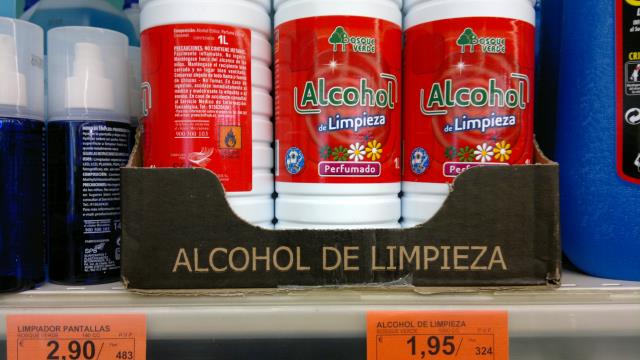
99% ethyl alcohol, 1% denaturing chemicals, 1 liter bottle, cleaning supplies department at the mercadona supermarket in spain, april 2014
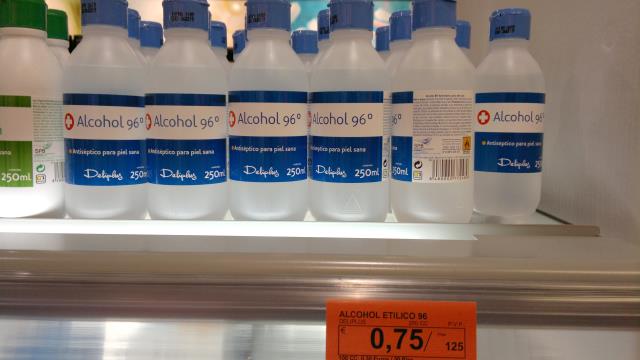
99% ethyl alcohol (front label says 96% but rear label says 99%), 1% denaturing chemicals, 250ml bottle, health/beauty suppplies department at the mercadona supermarket in spain, april 2014
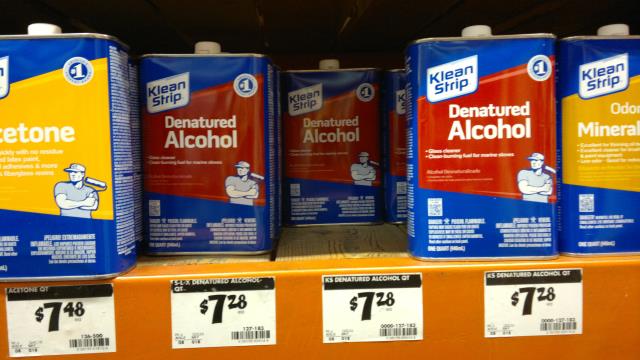
denatured ethyl alcohol, 32 oz, home depot hardware store, may 2014 (much more expensive per unit quantity than in spain, assuming 1.37 $/€ exchange rate, possible to buy ethanol in gallon containers at home depot at price only slightly higher per unit quantity than in spain)
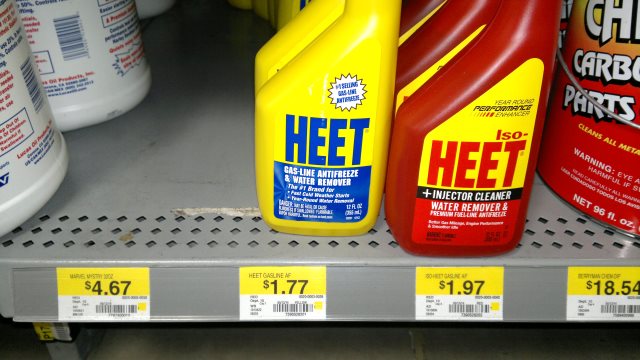
yellow bottle is methyl alcohol, red bottle is isopropyl alcohol, 12 oz bottles, automotive supplies department at walmart in reno, may 2014 (note that 32 oz of methanol would cost $4.72, or considerably cheaper than 32 oz denatured ethanol at home depot, however methanol has only about 75% of heat value as ethanol, so cost in terms of equivalent heating value would be $6.29/quart, which is still cheaper than ethanol)
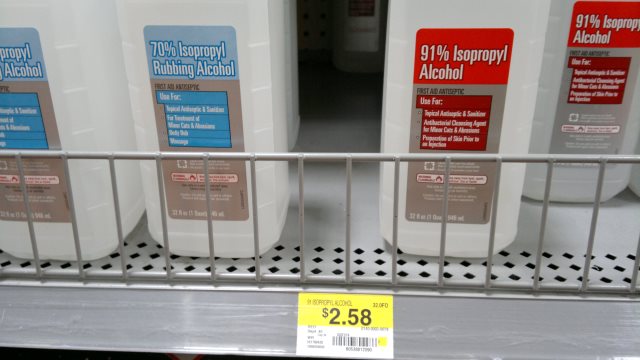
70% and 91% isopropyl alcohol, 32 oz bottles, health supplies department of walmart in reno, may 2014 (only use as last resort if no ethanol or methanol available)
Spark-lite Emergency Firestarter kit, from BackpackingLight, is a very lightweight and reliable system for starting emergency fire. This kit included in aviation survival kit of military. Includes flint and steel sparker plus 10 petrolatum soaked cotton tabs for use as tinder. I have some doubts as to advisability of fire in emergencies, at least when most of clothing and other equipment is made of highly flammable synthetics, which can be damaged by even a single spark. In olden days, clothing was usually wool or cotton, both of which are resistant to burning, and equipment alone was typically insufficient to stay warm in sub-freezing temperatures, so that fire was both non-dangerous and essential. But things are different nowadays. Given a choice between fire and equipment I normally carry, I would definitely prefer the equipment in an emergency. Thus it makes little sense to risk damaging that equipment by trying to start a fire under difficult conditions. So I don't carry a firestarter kit anymore. 20 grams.